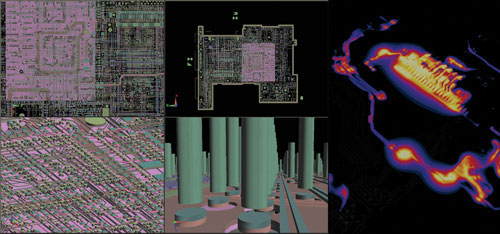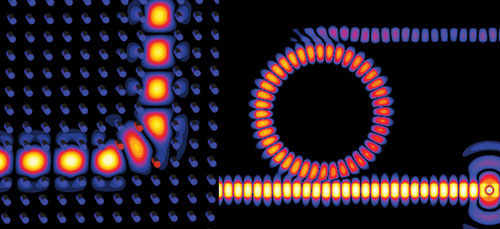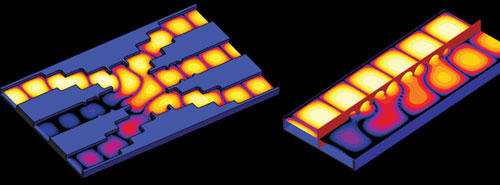 Today’s engineering environment puts diverse requirements on simulation tools, demanding large spatial dimensions in terms of the computational domain on the one hand, while incorporating small, detailed and complex structures on the other. What’s needed is to address these spatial limitations and apply more advanced simulation routines for combined physical problems. The latest release of SEMCAD X—V14 Aletsch—does just that by offering a novel suite of solutions that have been tailored to solve any of today’s engineering challenges within specific application fields such as antennas, medical, automotive, EMC/EMI, optics and microwave devices.
Today’s engineering environment puts diverse requirements on simulation tools, demanding large spatial dimensions in terms of the computational domain on the one hand, while incorporating small, detailed and complex structures on the other. What’s needed is to address these spatial limitations and apply more advanced simulation routines for combined physical problems. The latest release of SEMCAD X—V14 Aletsch—does just that by offering a novel suite of solutions that have been tailored to solve any of today’s engineering challenges within specific application fields such as antennas, medical, automotive, EMC/EMI, optics and microwave devices.
Problems in these engineering sectors include:
• Antennas: MIMO systems in the proximity of the human body embedded in a multipath propagation environment
• Medical: Assessment of the safety of implanted micro devices exposed to electromagnetic fields in a macro environment
• EMC/EMI: Power and signal integrity on multichip (MCM) PCBs
• Optical: Modeling a nano-structured photovoltaic solar cell
• Microwave: Broadband simulation of an entire 1,000 way unequal waveguide power divider
• Low frequency: A human body exposed to magnetic fields in the vicinity of an induction heating hob
All these challenges are centered on Maxwell’s equations and many different numerical approaches have been developed to solve these equations, each having their own advantages and limitations. The Finite-Difference Time-Domain (FDTD) method is well-suited to solving highly inhomogeneous structures (dielectric and metal), mainly due to its straightforward, robust and efficient approach. In addition, GPU-based hardware acceleration solutions, offering simulation times of up to 100 times faster in desktop form-factors, are still mostly tailored to FDTD solvers. Therefore, the FDTD method is more often suited to solving large and complex electromagnetic simulations.
SEMCAD X V14 Aletsch offers high performance EM and Thermal FDTD-based solvers; Finite Element Method (FEM)-based low frequency as well as static solvers—all in 32 and 64 bit, and on all available operating systems and platforms. In addition, special methods such as conformal solvers C-FDTD/FIT, ADI-FDTD and special material models (thin sheets, real metals, etc.) are provided. All these solvers are coupled with each other within different solutions and interfaced to NVIDIA GPU-based hardware acceleration provided by Acceleware Corp.
As mentioned earlier, the solutions are tailored to specific solutions, which will be addressed in turn.
Antennas
SEMCAD X ANTENNA enables accurate and fast broadband frequency characterization covering a full spectrum from miniaturized antennas to large reflecting/radiating structures. The multi-parameter (S-parameter, SAR and Near- & Far-field) and multi-goal optimization engine, based on a number of algorithms like Genetic, Tree, Powell and Swarm, enables the optimization of highly complex CAD imported and derived structures.

Figure 1 Detailed image of a cell phone (left) and far-field radiation from a cell phone in the proximity of the SAM head (right).
The SPICE-based Circuit Simulation co-engine performs full wave coupled co-simulation integrating circuits in the electromagnetic simulation. Python script-based specialized tools for antenna diversity (MIMO), hearing aid compatibility and Over-The-Air performance (OTA) in combination with a unique set of different hand and head phantoms, which are fully posable, allow the compliant prototyping of mobile phones, handsets and net/notebooks.
Radiation performance, efficiency, gain and directivity of the simulation can be verified using the integrated post-processing engine of near-field measurements from the DASY5 system. Figure 1 shows an example solved using the SEMCAD X ANTENNA solution.
Medical
SEMCAD X MED combines the EM FDTD, magneto-static, magneto-quasi-static and thermal solvers into a powerful and robust platform. The solution is trimmed to simulate and visualize electromagnetic fields interacting with human and biological tissues. The toolbox addresses modeling requirements from MRI design to implants and safety regulations.
Furthermore, a generalized Huygens Box excitation is available for the EM FDTD solver. The Huygens Box is a generalized Total-Field Scattered-Field (TFSF) plane wave excitation. Instead of defining a plane wave incident field, the field distribution from a previous simulation can be used to excite the Huygens Box.
Anatomical human and animal models offering great detail and accuracy are bundled into a large commercial library of CAD-based phantoms. The unrestricted choice of resolution as well as the fully customizable posture of the phantoms enables a fast and accurate exposure simulation. Many electromagnetically induced effects are directly coupled to temperature elevation within tissues and are addressed in the native combination of the EM and the advanced Thermal Solver.
It is based on various extensions of the Pennes bioheat equation, including anisotropic conductivity, temperature dependent parameters, discreet vasculature model, thin wire model, pseudo-1D boundary conditions, time dependent heat generation rate and a steady-state thermal solver.

Figure 2 Computed SAR distribution of the human body inside a MRI coil (left) and birdcage model loaded with anatomical adult male phantom in SEMCAD X (right).
Also, a pre-modeled medical device database includes generic birdcage CAD models as well as tools for the optimization of field uniformity and handling of the acquired MRI/CT data to be segmented and converted to a full CAD model. Figure 2 shows an example solved using the SEMCAD X MED solution.
EMC/EMI Testing
SEMCAD X EMC approaches the complexity of compliance and interference simulation for EMC/EMI testing using the speed and performance of the GPU hardware accelerated full wave simulation. The 3-D solid modeler, based on the ACIS modeling toolkit, allows a rapid import and processing of various CAD formats and features using a fast OGL-based rendering engine, implemented in-house.

Figure 3 PCB layout imported from ODB++ (CAD model and Netlist) as well as the simulated current distribution on the digital line of the 20 layer PCB board.
The ODB++ hierarchical format incorporating the entire CAD/CAM data is natively imported and can be combined with the SPICE co-simulator for signal and power integrity in the time and frequency domain, e.g. for PCB applications (see Figure 3). Also, broadband frequency response is available using arbitrary custom pulse shaped excitations.
Applying the GPU acceleration and dedicated special techniques allow performing the simulation of various EMC applications such as ESD, NEMP and lightning pulses. A virtual toolbox consisting of anechoic, reverberation and TEM cell chambers is also available. Together with the extremely powerful visualization engine for near and far fields as well as Python scripting-based tools for extraction of peak fields give a powerful method that can be used for virtual prototyping and the compliance-testing environment for a large number of EMC applications.
Optical
SEMCAD X OPTICS is tailored to simulate large active/passive optical devices described by the advanced material database, including Debye, Lorentz, Drude and Drude-Lorentz-Debye on the native GPU accelerated platform. Pole and relaxation times of measured materials can be extracted with a dedicated material Genetic Algorithm-based optimization routine to a stable combination of Drude-Lorenz-Debye, while the accuracy of the model can be controlled in the optimization routine.

Figure 4 Field distribution of an optimized 90° optical waveguide bend (left) and an add/drop ring coupler for optical filtering at 550 nm (right).
The optical material definition includes the Kerr-effect (linear intensity dependence of the relative permittivity or permeability) and Raman-scattering, describing the scattering of light at phonons (lattice vibrations). Optical waveguides, filters, photonic crystals, nano-particles and plasmonic resonant structures can be optimized using a framework of four advanced optimization methods based on Genetic Algorithms, Particle Optimization and Bracketing Techniques. Figure 4 shows a typical example using the SEMCAD X OPTICS solution.
Extremely Low Frequencies
SEMCAD X ELF incorporates advanced static and quasi-static solvers, which address today’s increased number of low frequency industrial and research applications. Five different FEM-based solvers are available: Electro Static, Stationary Currents (electro quasi-static with dominating ohmic currents), Electro Quasi-Static, Magneto Quasi-Static and Magneto Static (Biot-Savart).

Figure 5 H-field distribution along a lower line (left) and Electro-Quasi-Static solution of the induced currents in a human phantom inside a gradient z-coil of a MRI system (right).
In addition to the established low frequency applications such as power lines (see Figure 5), the user can apply the entire range of SEMCAD X’s posable anatomical high-resolution full body human/animal models for radio frequency ablation in cancer treatment as well as various other biomedical applications.
Microwaves
SEMCAD X µWAVE is an advanced EM full-wave solution for fast and accurate design of microwave devices. A set of different time-domain solvers centered on the standard FDTD method are available: FDTD, FIT/C-FDTD, ADI-FDTD and FIT/C-ADI-FDTD. The ability to use conformal mesh FIT/C-FDTD results in a coarser spatial resolution that nonetheless produces accurate results, while reducing substantially the computational effort. Also, the ADI-FDTD solver is well suited to highly over-discretized simulation setups, as well as for simulations at very low frequencies.

Figure 6 Field distribution inside a six-port waveguide coupler (left) and inside a circular multi-aperture narrow-wall waveguide coupler (right).
Automated or user defined healing is available for the vast set of CAD formats: SAT, IGES, STEP, 3DS, CATIA V4/V5, Pro/E, STL, I-DEAS, DXF, Gerber, ODB++ and various voxel/binary importers. Manipulation of 50,000 parts or more is achievable with the OGL-based 3D QTech rendering engine, which has been developed in-house. Fully parameterized modeling can perform simulations of statistically distributed parameter values in addition to the advanced optimization routines available. Figure 6 shows typical examples using the SEMCAD X µWAVE solution.
Additional Features
Listed above are the application specific features, but SEMCAD X V14 Aletsch also has numerous new features that are solution independent. These include:
• Next generation GUI
• New CAD importer
• Multi-view model window and perspective camera for better visualization and handling of most complex models
• Optimizer 3: full redesign and reintegration of SEMCAD’s optimization platform to integrate all solvers and distribute an optimization using multiple machines on the network
• New posable human and animal body models in SEMCAD X POP
• Doubling of the computation power when using new NVIDIA GPU & Acceleware hardware solutions
• Titled lumped elements and edge sources
• Extended material handling functionality, extension of the materials database
• True 64 bit support for simulations > 1 BCells
Conclusion
The new SEMCAD X V14 Aletsch release builds on the existing and established strengths of the SEMCAD X to offer a novel suite of solutions that have been tailored to specific applications. It offers scope and flexibility to address the wide variety of challenges that engineers typically encounter.
Schmid & Partner Engineering AG (SPEAG), Zurich, Switzerland
Tel: +41 44 245 9700
e-mail: info@speag.com
www.speag.com.
RS No. 300
